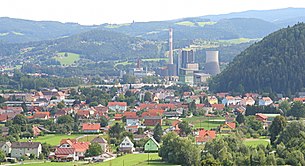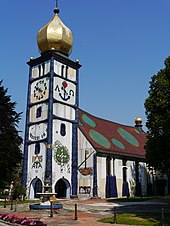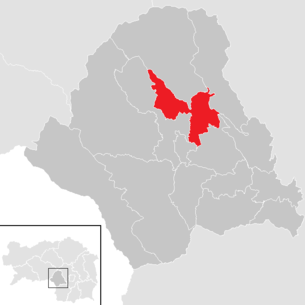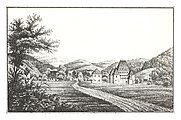Bärnbach
|
Borough Bärnbach
|
||
|---|---|---|
| coat of arms | Austria map | |
|
|
||
| Basic data | ||
| Country: | Austria | |
| State : | Styria | |
| Political District : | Voitsberg | |
| License plate : | VO | |
| Surface: | 31.58 km² | |
| Coordinates : | 47 ° 4 ' N , 15 ° 7' E | |
| Height : | 424 m above sea level A. | |
| Residents : | 5,658 (Jan 1, 2020) | |
| Postal code : | 8572 | |
| Area code : | 03142 | |
| Community code : | 6 16 26 | |
| NUTS region | AT225 | |
| Address of the municipal administration: |
Hauptplatz 1 8572 Bärnbach |
|
| Website: | ||
| politics | ||
| Mayor : | Jochen Bocksruker ( SPÖ ) | |
|
Municipal Council : (Election year: 2015) (25 members) |
||
| Location of Bärnbach in the Voitsberg district | ||
 Panorama with the now demolished Voitsberg steam power station |
||
| Source: Municipal data from Statistics Austria | ||
Bärnbach is a municipality in the judicial district or district of Voitsberg in the state of Styria , Austria . On 1 January 2015, as part municipality structural reform the church Piberegg incorporated.
The municipality in western Styria covers an area of 31.58 km² and is the third largest city in the Voitsberg district with 5658 inhabitants (as of January 1, 2020).
geography
The municipality of Bärnbach is located in the eastern part of the Voitsberg district, about 17 kilometers west of the provincial capital Graz . The city is located in a valley between the Holy Mountain and the Knobelberg in the west and the mountain ranges of Hochtregist in the east, at the entrance to the upper Kainach valley . The Kainach flows through the urban area from north to south. In the northwest, the Freisingbach forms the municipal boundary to Kainach near Voitsberg .
The area of the municipality is 31.58 km², of which 29.13 km² (as of 2010) is used as agricultural and forestry area. The city center is 424 meters above sea level, while the Hirtlkogel on the municipal border with Köflach is the highest point in the city at 961 meters.
geology
The area around the center of Bärnbach belongs geologically to the West Styrian Basin and lies on its northern edge, while the cadastral communities Hochtregist and Piberegg belong geologically to the western part of the Graz mountainous region . The basin location is dominated by sedimentary layers from the Miocene , which lie over the Cretaceous crystalline layers of the Kainacher Gosau and sequences of the Graz Paleozoic , while the Kainacher Gosau is not covered in the higher elevations. The Miocene strata of the West Styrian Basin show deep red earth soils and conglomerates of limestone, some of which are interspersed with weathered debris . In the area around Bärnbach several hollows were discovered which led to larger, mineable seams of lignite , which were mainly mined in the Oberdorfer Mulde . The lignite was formed limnic, i.e. in the vicinity of a freshwater lake, and dates from the Ottnangian period .
climate
In the municipality of Bärnbach, there is a continental , cold-temperate climate , which is influenced on the one hand by the striking basin location but also by the protected location on the foothills of a mountain range . The winter half of the year is characterized by a pronounced lack of wind, with the main wind directions strongly depending on the diurnal valley winds . The region also has an increased tendency to form valley fog .
There can be significant rainfall throughout the year, with the maximum in summer and the minimum in winter. The average annual rainfall is 917 mm. The month with the lowest rainfall is January with a rainfall of 36 mm. On the other hand there is July, which is the wettest month with an average of 128 mm. The annual mean temperature is 7.9 ° C. The warmest month is July with an average temperature of 18.4 ° C. In January, the coldest month, the average temperature is −3.5 ° C.
|
Average monthly temperatures and rainfall for Bärnbach
Source:
|
|||||||||||||||||||||||||||||||||||||||||||||||||||||||||||||||||||||||||||||||||||||||||||||||||||||||||||||||||||||||||||||||||||||||||||||||||||||||||||||||||||||
Community structure
The municipality is divided into three cadastral municipalities , which were originally all independent municipalities, and four localities. The district of Bärnbach is also divided into the four districts of Bärnbach, Kleinkainach , Mitterdorf and Oberdorf . The Peter Leitner settlement is located in the south-western part of the municipality and the Piberegg Rollsiedlung is in the central part of the municipality. There are also the four Rotten Afling , Freisinggraben , Hochtregist and Marienschacht in the north, northwest, south and east of the city.
The community is divided into four localities (residents as of January 1, 2020):
- Bärnbach (4218 Ew.)
- Hochtregist (1108)
- Piberegg (162)
- Piberegg Rollsiedlung (170) (also Josef-Roll-Siedlung)
The community consists of three cadastral communities (area: as of December 31, 2018):
- Bärnbach (455.36 ha)
- Hochtregist (1,260.17 ha)
- Piberegg (1,436.94 km²)
Neighboring communities
The following cities, municipalities and localities border the city of Bärnbach in a clockwise direction:
- in the north the community Kainach bei Voitsberg with the scattered settlement Breitenbach , the localities Kainach bei Voitsberg, Hemmerberg and Kohlschwarz , the Karl Ortner settlement, the Rotten Freisinggraben and Afling as well as the Bocklochgraben
- in the northeast the community Geistthal-Södingberg with the bathing settlement and the village Södingberg
- in the southeast the municipality of Voitsberg with the districts Lobmingberg , Tregist and Kowald
- in the south the community of Rosental an der Kainach
- in the southwest and west the municipality of Köflach with the villages of Piber , Gradenberg and Graden and the districts of Knobelberg , Mitsch , Krenhof , Sonnleiten and Mitteregg
Incorporations
- On January 1, 1952, the previously independent municipality of Hochtregist was merged with the municipality of Bärnbach.
- On January 1, 2015, in the course of the Styrian municipal structural reform, the municipality of Piberegg and Bärnbach were merged to form the newly created municipality of Bärnbach.
history
Archaeological finds on the Holy Mountain have proven that the area around Bärnbach has been settled since the Neolithic . In the time around 800 BC, during the younger urn field culture , a large and fortified hilltop settlement was built on the Holy Mountain for the time . During the excavations carried out by the Landesmuseum Joanneum in 1975/1976 in the hilltop settlement, the remains of houses and numerous clay pots were uncovered, which led to the assumption that this hilltop settlement was a so-called pottery village. In addition, evidence of a settlement of the Holy Mountain during the Celtic and Roman times as well as during late antiquity was discovered during this excavation. Several Roman stones were found from the Roman Empire. Around 600 BC the Slavs began to settle in the area around Bärnbach. From the 10th century onwards, Bavarian settlers began to immigrate , which meant that the Slavic influences were increasingly displaced by Bavarian ones. Today some Slavic place names still remind of the original Slavic population.
The place Bärnbach was probably founded only a short time after the parish of Piber , but before 1100 in the so-called forest by Bavarian settlers at the confluence of the Freisingbach in the Kainach . The first documented mention as Pernpach in the Rationarium Styriae took place in 1268/69, another mention as Hirzo de Perinpach took place in 1277. An important road led along the Kainach into Upper Styria through the place at that time . Mainly grain and wine were brought to the area around today's Knittelfeld on it, and from there salt and iron to Voitsberg . To protect this street, the Alt-Kainach Castle was probably built in the 13th century , which was built from an original defense tower. In 1400 Rudolf Lichtenegger, the then abbot of the St. Lambrecht Monastery, enfeoffed the knight Hans Gradner with five estates in Bärnbach and Gößnitz . The Kleinkainach and Krottenhof castles were also built in the 14th century . The knight family of Kainach , who were raised to the nobility in 1553, played an important role in the development of Bärnbach from the 13th to the beginning of the 17th century. But since the Kainachers were Protestants , they left Styria in 1603 and bought goods in Lower Austria.
In 1782 it was mentioned in a document as Bernbach . Bärnbach was a small place with a purely rural structure until the 19th century, so in 1825, according to the Franziszeischen cadastre, the place consisted of 25 houses. When the villages of Hochtregist , Mitterdorf and Oberdorf merged , the village began to grow and develop into a larger town. The population grew mainly due to the now started mining of lignite in Oberdorf and the Oberdorf glassworks, which was founded in 1805 and which today belongs to the Stölzle Glass Group .
After 1945 some school classes were relocated from the surrounding area to Bärnbach and the construction of settlements, a ballroom and a cinema began. On January 1, 1952, the previously independent municipality of Hochtregist was merged with Bärnbach. In the following year Bärnbach was raised to a market town . In 1977 the city was appointed.
In June 2018 it was announced that Bärnbach and its neighboring municipality of Voitsberg were planning to merge under the name Voitsberg-Bärnbach by the end of 2019 . An additional inclusion of the communities of Köflach , Rosental and Maria Lankowitz was discussed in June 2018 - this idea for a West Styria city is older. A merger of Köflach, Voitsberg and Rosental alone would have created the second largest city in Styria after Graz with 25,000 inhabitants. The plans failed because of the results of a public survey. While the population of Voitsberg voted for a merger of the two communities, the Bärnbach citizens were largely against it.
Place name
The name Bärnbach consists of the two syllables Bear and -bach together. While the part of the name -bach suggests a stream , the part of the name Bärn- is derived from either the Old High German Pero for bear or the Old High German personal name Pero or Bero . The place name means either Bärenbach or Bach des Pero.
Population development

Culture and sights

- Hundertwasser Church: The main attraction is the parish church of St. Barbara, which was built in 1948 and redesigned mainly outside by the architect Friedensreich Hundertwasser in 1988 and is now known as the Hundertwasser Church . In contrast, the interior is simple and designed by a few local artists. The glass windows were designed by Franz Weiss . A cycle of pictures about our father was designed by Kurt Zisler.
- Stölzle-Oberglas : The company's glass museum shows exhibits on the history and technology of the glassblowing trade. In recent years the city of glass and coal has developed into a city of art and culture.
- Historical monuments on the " Holy Mountain " with its three thousand year settlement history and the Carmel monastery and the renaissance castle Alt-Kainach , whose Romanesque-Gothic fortified tower was built in the 13th century. A castle history museum has been located in Alt Kainach Castle since 1968.
- Moses Fountain : Ernst Fuchs created the fountain in 1998 .
- 1992 Facade of the New Middle School, designed by the artist Robert Zeppel-Sperl
- Local chapel Tregist in Hochtregist , designed by Franz Weiss
Moses Fountain by Ernst Fuchs
economy
In earlier times, Bärnbach was particularly known for its coal mine and the art of glass blowing. Today important economic enterprises are:
- the Bärnbach Glass Center
- the WEZ (West Styrian Shopping Center)
- Binder combustion technology
- the Remus company
- the Telepark Bärnbach as a source of inspiration and a hub of know-how
tourism
Together with Köflach, Maria Lankowitz and Voitsberg, the municipality forms the Lipizzanerheimat tourist association. Its seat is in Köflach.
Public facilities
The city of Bärnbach is the only city in Styria that does not have its own police station . This was closed in 2004. In 2008 and 2010, the Styrian Landtag passed motions calling on the federal government to reopen a police station. However, these applications have not yet achieved their goal.
politics
After the election in March 2015 , the municipal council consisted of:
- 15 SPÖ mandataries
- 6 mandataries of the ÖVP
- 3 mandataries of the FPÖ
- 1 mandate from SBB (Social Movement Bärnbach)
mayor
- 2004-2014 Maximilian Kienzer (SPÖ)
- 2014–2019 Bernd Osprian (SPÖ)
- since 2019 Jochen Bocksruker (SPÖ)
coat of arms
Both previous communities each had a community coat of arms. Due to the amalgamation of municipalities, these lost their official validity on January 1st, 2015.
The municipal coat of arms for Bärnbach was awarded on September 1, 1953 with effect from September 15, 1953, the reassignment took place unchanged with effect from September 30, 2015.
Blazon (coat of arms description):
- "In a golden shield, criss-crossed by a lowered blue wavy bar, above a black bear with red tongues and armored striding to the right, below an entire golden five-petalled red rose with green angular leaves."
Personalities
Honorary citizen
- 1977: Johann Bammer (1922–2017), Provincial Councilor
sons and daughters of the town
- Josef Modl (* 1931), politician of the SPÖ , member of the National Council 1975–1984
- Toni Maier (* 1949), musician, educator and composer
literature
- Ernst Lasnik : Bärnbach. From village to city . Bärnbach 2007.
- Walter Brunner (Ed.): History and topography of the Voitsberg district . tape 2 . Steiermärkisches Landesarchiv, Graz 2011, p. 16-23 .
Web links
- 61626 - Bärnbach. Community data, Statistics Austria .
- www.baernbach.at Website of the municipality
Individual evidence
- ↑ Announcement of the Styrian state government of September 26, 2013 on the unification of the municipality of Bärnbach and the municipality of Piberegg, both political district of Voitsberg. Styrian Provincial Law Gazette of October 14, 2013. No. 101, 28th issue. P. 556.
- ↑ a b c d e f Stadtgemeinde Bärnbach: history, figures, data, facts. In: baernbach.gv.at. Retrieved January 2, 2019 .
- ↑ Agriculture and forestry businesses and areas by type of occupation (Bärnbach). (PDF) In: statistik.at. Statistics Austria, accessed on January 2, 2019 .
- ↑ Agriculture and forestry businesses and areas by type of occupation (Piberegg). (PDF) In: statistik.at. Statistics Austria, accessed on January 2, 2019 .
- ↑ Landscape structure of Styria. In: Environment.steiermark.at. The State of Styria, accessed on January 2, 2019 .
- ^ Fritz Ebner : The geological map sheet Voitsberg (ÖK 163) and remarks on geology in the area of St. Pankrazen . In: Reports of the Institute for Geology and Paleontology of the Karl-Franzens-University Graz. No. 3 , 2011, ISSN 1608-8166 , p. 13-14 .
- ^ Leopold Weber, Alfred Weiss: Mining history and geology of the Austrian lignite deposits . In: Archive for deposit research of the Federal Geological Institute . No. 4 , 1983, ISBN 3-900312-26-5 , ISSN 0253-097X , p. 43-44 .
- ↑ Climatic region Voitsberg-Köflacher basin. In: Environment.steiermark.at. The State of Styria, accessed on January 2, 2019 .
- ↑ a b Climate: Bärnbach. In: de.climate-data.org. AmbiWeb GmbH, accessed on January 2, 2019 .
- ↑ Statistics Austria: Population on January 1st, 2020 by locality (area status on January 1st, 2020) , ( CSV )
- ↑ CSV file from REGIONALINFORMATION.zip (1,221 kB) ; accessed on January 12, 2019
- ^ A b c Walter Brunner (Ed.): History and topography of the Voitsberg district . tape 2 . Steiermärkisches Landesarchiv, Graz 2011, p. 16 .
- ↑ Voitsberg and Bärnbach are planning a merger, steiermark.orf.at on June 6, 2018.
- ↑ Is the "West Styria City" coming now? orf.at, June 7, 2018, accessed June 7, 2018.
- ↑ The merger of Voitsberg and Bärnbach burst after a public survey. In: Tyrolean daily newspaper . November 24, 2018, accessed March 18, 2019 .
- ↑ Lush outside, plain inside ( Memento from November 3, 2014 in the Internet Archive )
- ^ Grazer Zeitung , Official Gazette for Styria. December 30, 2014, 210th year, 52nd piece. No. 309. ZDB -ID 1291268-2 pp. 626-627.
- ↑ Renewed demand for the reopening of a police station in Bärnbach ( Memento from February 22, 2014 in the Internet Archive ) Application of the Styrian state parliament, February 9, 2010, entry no. 3536/1, accessed October 27, 2016.
- ↑ Stadtgemeinde Bärnbach: Municipal Council , accessed on June 6, 2018.
- ↑ Maximilian Kienzer: Not an easy time. Kommunalnet, Julia Rotter, February 7, 2014
- ^ Orf.at: Bärnbacher Mayor goes to Voitsberg . Article dated February 26, 2019, accessed April 5, 2019.
- ↑ Kleine Zeitung: BärnbachJochen Bocksruker solemnly sworn in as mayor , article from April 2, 2019, accessed on April 5, 2019.
- ↑ 73. Announcement of the Styrian state government of September 10, 2015 on the granting of the right to use a municipal coat of arms to the municipality of Bärnbach (political district Voitsberg) , accessed on September 23, 2015
- ^ Neue Zeit (April 5, 1977), p. 7.













